
How to grow and care for the San Pedro cactus
Growing plants is a very satisfying endeavour—even more so when they make you trip! Here, we'll look at how to grow San Pedro—an iconic psychoactive cactus—from seeds and cuttings.
San Pedro is a mescaline-containing cactus from South America. Revered for its psychedelic properties, it doesn’t need to be harvested from the wild! You can grow this cactus in the comfort of your own home or garden—so long as you have several years to spare!
In this article, we’re looking at how to grow San Pedro from both cuttings and seeds, and then exploring its specific needs once it’s germinated!
What is the San Pedro cactus?
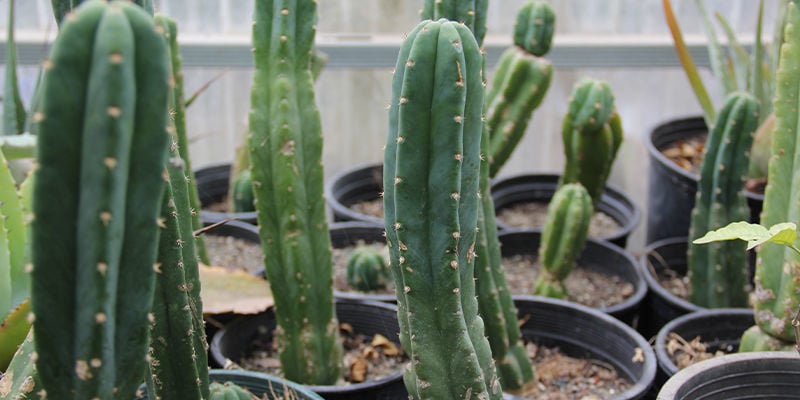
The San Pedro cactus (Echinopsis pachanoi), native to the Andes mountain range of South America, is a relatively fast-growing, columnar cactus cherished by enthusiasts for its striking appearance, resilience, and, of course, its mescaline content.
Origin and characteristics
San Pedro originates from the high altitudes of the Andes in Peru, Ecuador, and northern Argentina. In these regions, the cactus has long been used as an essential part of spiritual and religious practices by indigenous peoples—as have various mescaline-containing cacti from throughout the Americas.
Compared to other mescaline cacti, such as peyote, San Pedro grows much faster, saving cultivators years of waiting. Though it can take around 5 years on average to harvest homegrown San Pedro for its mescaline content, growing peyote can take 10 years or more!
Additionally, San Pedro can reach impressive heights, especially when provided with optimal care or when left to grow naturally in its ideal habitat. For those growing at home, its "fast" growth rate makes San Pedro highly appealing, especially if you’re looking to harvest it for its psychedelic properties.
These cacti have ribbed, columnar stems that are typically light to dark green, sometimes exhibiting a bluish hue as they mature. San Pedro produces large, fragrant white flowers that bloom, somewhat romantically, at night during the summer months.
Benefits of growing San Pedro cactus
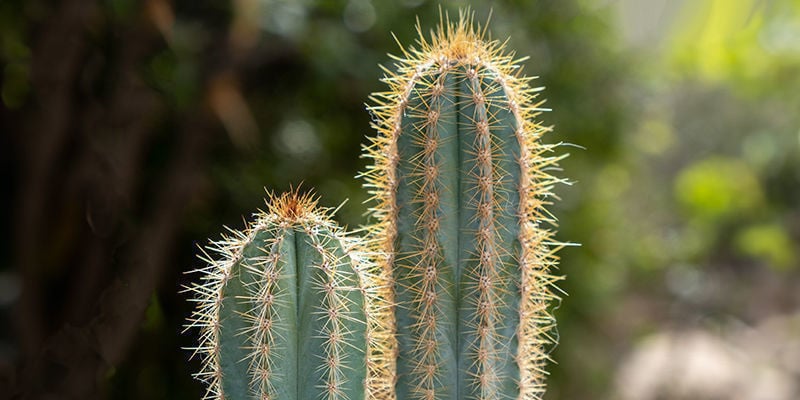
Perhaps the main benefit of growing San Pedro is that, once mature, it contains a high concentration of mescaline, meaning it provides an effective way of sourcing this psychoactive alkaloid at home. Green-fingered psychonauts interested in traditional South American spiritual practices may find it particularly appealing.
What’s more, it’s a pretty plant too. Even if its ornamental value isn’t your driving motivation, you’ll be pleased to have an attractive cactus growing in your home or garden while you wait to harvest it.
Planting your San Pedro cactus
To grow San Pedro, you obviously need to plant it. This can be done from seeds or cuttings, and requires certain pieces of equipment to be successful.
San Pedro seeds vs cuttings: Planting methods
There are two ways to grow San Pedro: from seeds or from cuttings. Cuttings offer a quicker route to harvest, as a significant portion of the growing is already done. Seeds, however, offer growers the opportunity to be involved from the very beginning, and remove some of the complexities involved in helping a cutting take to new soil.
Growing from cuttings
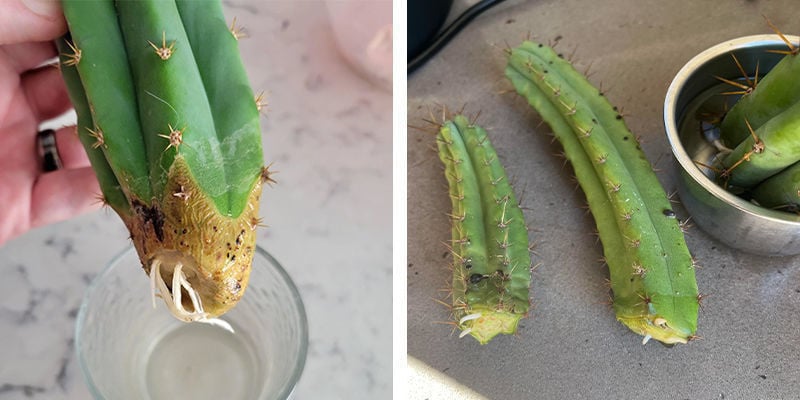
Here are the key steps to bear in mind when growing from a San Pedro cutting:
- Choose a healthy cutting, ideally at least 10 cm long, to ensure robust growth.
- Allow the cutting to dry for approximately four weeks in a shaded area to form a callous, which helps to prevent rot upon planting.
- Once cured, plant the cutting in well-draining soil, burying it just enough to support its upright position.
- Initially, water sparingly until roots develop, then gradually increase watering frequency during the growing season.
Growing from seeds
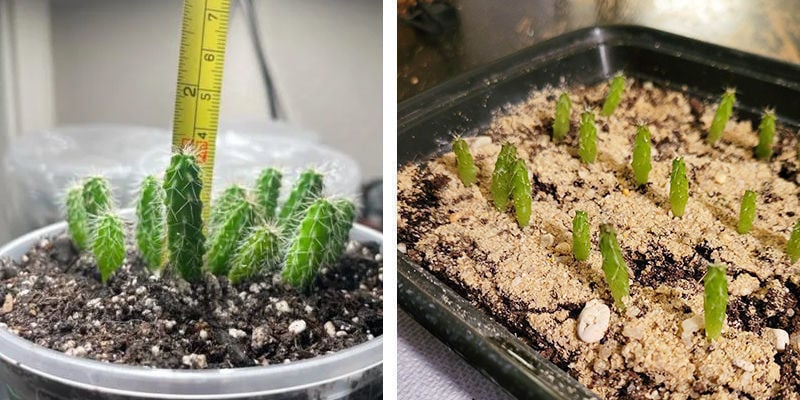
If growing from seeds, the process will be more familiar to most.
Here’s what you need to do:
- Scatter seeds on the surface of a well-draining soil mix, lightly pressing them into the soil without fully covering them.
- Maintain a warm environment around 27°C during the day and 21°C at night. Keep the soil consistently moist but not waterlogged.
- Provide bright, indirect light to encourage germination, which can take several weeks to months.
Pot selection and drainage
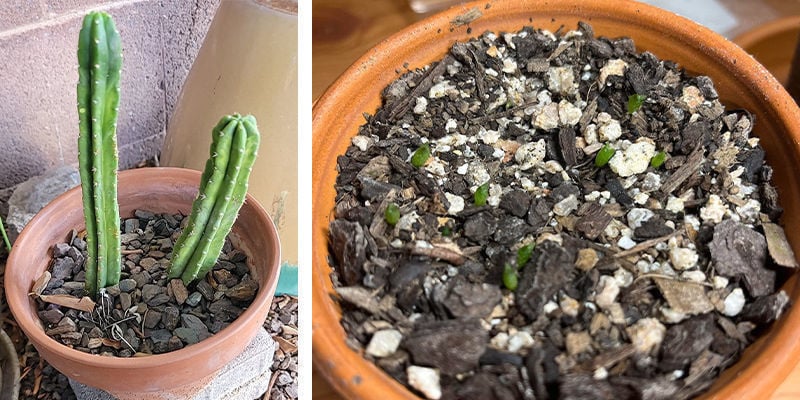
As you probably know, cacti are masters of growing in dry conditions. So when you choose a pot, it’s key to select one that doesn’t hold onto too much water and allows for adequate aeration. You don’t need anything special. Terracotta pots are ideal as they promote soil aeration and prevent water retention. Alternatively, you could also try a fabric pot, although these aren’t as popular for growing cacti.
Equipment
Regarding further equipment, you don’t need anything special that you wouldn’t use for growing other plants.
Here’s what you need:
- Gloves: These will protect your hands from the spines.
- Soil: Prepare a well-draining mix, incorporating materials like coarse sand, perlite, and peat moss—or buy a cactus mix.
- Watering can: Use a watering can with a narrow spout to direct water to the soil, avoiding the cactus stem.
Ideal growing conditions
San Pedro grows in arid, mountainous environments, so you want to replicate these when growing it at home. These cacti don’t thrive in the same kind of heat that some cacti do, but they do require warm, dry conditions in order to survive. Let’s take a look.
Light requirements
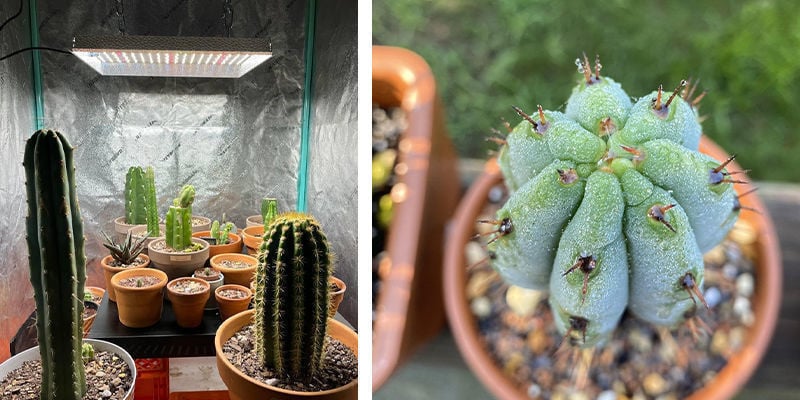
In terms of daylight, San Pedro likes a lot of it! Ideally, your cactus needs six to eight hours of direct sunlight each day. While it can tolerate partial shade, it thrives in direct sunlight. If growing indoors, you should position your specimen near a south-facing window in order to achieve this. You can also use grow lights to supplement or replace natural sunlight.
If growing outdoors, ensure your cactus is placed in a sunny spot.
Temperature and humidity
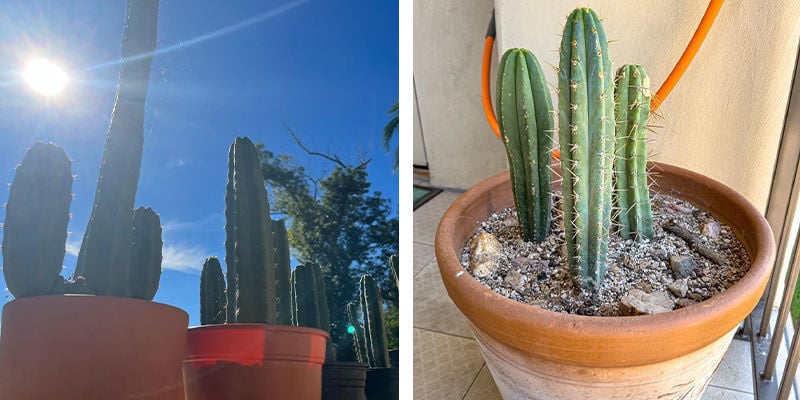
These cacti prefer warm temperatures between 15–27°C. While they can withstand occasional dips to 10°C, prolonged exposure to cold can be detrimental. Being adapted to dry environments, they do not require high humidity. Ensure good air circulation to prevent fungal issues and encourage healthy growth.
Choosing the right soil
Opt for a well-draining soil mix, such as a commercial cactus mix or a blend of coarse sand, perlite, and peat moss. A slightly acidic to neutral pH is ideal for optimal nutrient uptake, and ensuring the soil remains in the correct range will prevent your cacti from running into nutrient-related problems.
San Pedro cactus watering schedule
During the active growing season (spring and summer), water thoroughly when the top 5 cm of soil are dry, typically every two weeks. However, you should judge this by touch and not just assume that it is time to water. In autumn and winter, reduce watering to once a month or less, allowing the soil to dry out completely between waterings.
It’s possible to both overwater and underwater San Pedro (with the latter being very difficult!).
Here are the symptoms:
- Signs of overwatering: Soft, mushy stems and a general decline in plant health indicate overwatering.
- Signs of underwatering: Wrinkled or shrivelled stems suggest the cactus requires more moisture.
Feeding
Although they come from a very specific environment, these plants actually have very generic feeding habits! You can use standard plant food to feed your San Pedro, and you’ll be met with great results. But there are a few factors to be aware of.
They are not as ravenous as some plants, so around half the recommended dose of fertiliser will usually suffice. We suggest finding an organic food option, as this is better for both the plant and the environment. What’s more, organic feeds remove most of the risks associated with overfeeding, which will make your life easier in the long run.
Apply the feed as frequently as recommended throughout the growing season (spring to late summer), and don’t feed throughout the autumn and winter months.
How to take care of your San Pedro cactus
Cacti are hardy beings, and they don’t require coddling. Nevertheless, if you’re growing San Pedro at home, you'll still need to care for them from time to time. Mostly, aside from feeding and watering, this involves pruning and repotting every couple of years.
Pruning

Pruning involves cutting away dead or dying growth and allows the plant to spend its energy where it’s beneficial. Therefore, pruning is essential to healthy, vigorous growth. What’s more, pruning can help to modify the shape of your cactus and prevent excessive leaning or top-heaviness, which can become problematic.
The best time to prune is at the beginning of the growing season, when the specimen still has adequate time to heal. Avoid pruning late in the summer or throughout the dormant months, as this will cause damage.
Here’s how to prune your San Pedro cactus:
- Use a clean, sharp knife or pruning shears to prevent damage.
- Identify sections that need pruning, such as overcrowded growth, damaged areas, or if your cactus has reached an excessive height.
- Make a clean, diagonal cut to reduce the risk of disease and improve water drainage on the cut surface.
- Allow the cut surface to callous over for a few weeks before replanting (if using the cutting for propagation).
- Keep the plant in a warm, dry location while the cut heals to prevent infection.
Repotting San Pedro cactus
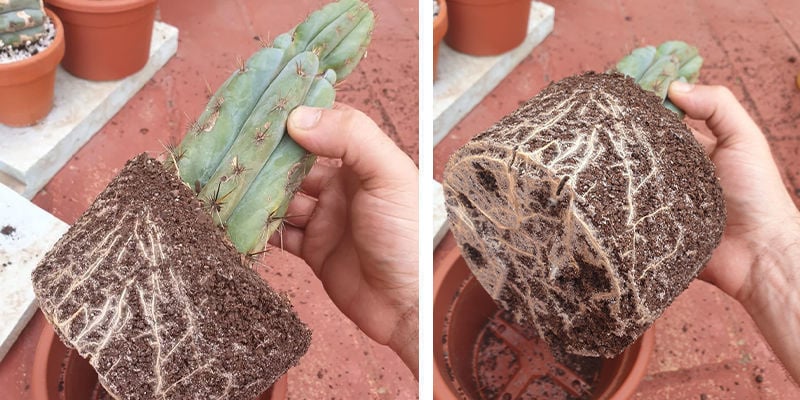
As it grows, San Pedro will also require repotting every two to three years so it doesn’t become rootbound. Other reasons to repot might be because the soil is compacted or retains too much moisture, leading to poor drainage.
Here’s how to repot San Pedro:
- Choose a new pot. It should be 3–5 cm larger in diameter than the current one. Use terracotta or ceramic pots for better air exchange.
- Prepare fresh soil. Use a well-draining cactus mix with added sand or perlite. Avoid standard garden soil, as it retains too much moisture.
- Remove the cactus carefully. Wear gloves to protect against spines. Gently loosen the soil around the roots and lift the plant out.
- Inspect and trim roots. Remove any rotting or damaged roots. Let the roots dry for a day before replanting to prevent rot.
- Repot. Fill the bottom with fresh soil, position the cactus upright, and add more soil around the base. Leave a small gap at the top to prevent soil from spilling during watering.
- Allow the plant to settle for a week before resuming watering. This prevents root shock and reduces the risk of rot.
Growing San Pedro: Get started!
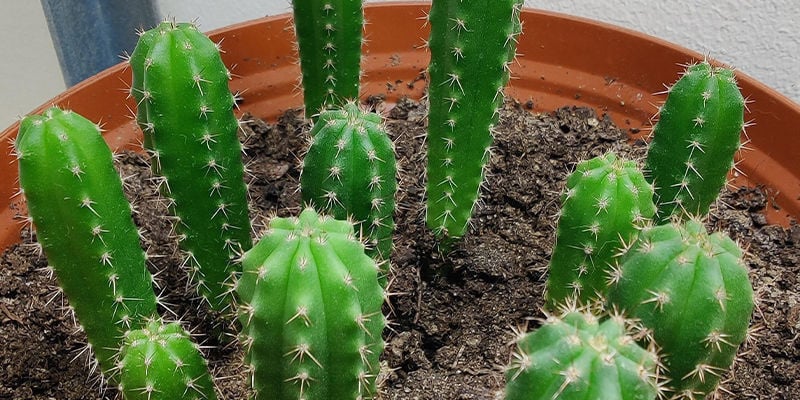
Cultivating your very own Echinopsis pachanoi isn’t the quickest procedure in the world, but it is satisfying for those who enjoy growing plants. Being a cactus, it’s pretty easy to look after and only requires a modicum of care to thrive. It’s also an attractive plant, and an enjoyable option for those looking to grow their own psychedelics.
So long as you are aware of its quirks and are willing to repot every few years and give it the care it needs, it’s sure to reward you!
-
 6 min
11 July 2024
The Ultimate Mescaline Cactus Guide
Mescaline is a time-honoured but often misunderstood drug. Here we aim to demystify it somewhat, and give a general overview of everything you need to know about mescaline cacti!
6 min
11 July 2024
The Ultimate Mescaline Cactus Guide
Mescaline is a time-honoured but often misunderstood drug. Here we aim to demystify it somewhat, and give a general overview of everything you need to know about mescaline cacti!
-
 5 min
27 November 2019
How To Grow Your Own Mescaline Cactus From Seed
Mescaline is a natural psychedelic produced by several types of cactus including peyote, San Pedro, and the Peruvian torch. These cacti are easy enough to grow, even if you don't have a lot of...
5 min
27 November 2019
How To Grow Your Own Mescaline Cactus From Seed
Mescaline is a natural psychedelic produced by several types of cactus including peyote, San Pedro, and the Peruvian torch. These cacti are easy enough to grow, even if you don't have a lot of...
-
 3 min
12 October 2019
How To Cultivate Cacti From Cuttings
If you want to grow mescaline cacti, you can do so from seed; but the more common (and faster) way is to propagate them from cuttings. Although rooting mescaline cacti cuttings is not too...
3 min
12 October 2019
How To Cultivate Cacti From Cuttings
If you want to grow mescaline cacti, you can do so from seed; but the more common (and faster) way is to propagate them from cuttings. Although rooting mescaline cacti cuttings is not too...
-
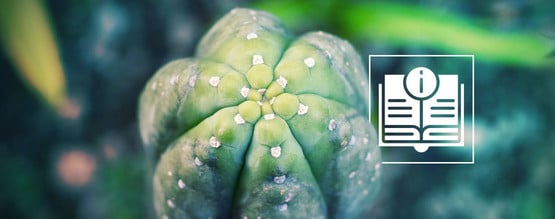 2 min
27 September 2019
A Guide To San Pedro
With a deep and rich history in shamanic practice, San Pedro is a great addition to any psychonaut’s hallucinogenic garden.
2 min
27 September 2019
A Guide To San Pedro
With a deep and rich history in shamanic practice, San Pedro is a great addition to any psychonaut’s hallucinogenic garden.
-
 3 min
6 October 2018
Top 5 Mescaline Cacti
Mescaline occupies the esteemed podium of naturally occurring hallucinogens along with DMT and psilocybin. The alkaloid can be found in a variety of cactus species. Here are the top 5...
3 min
6 October 2018
Top 5 Mescaline Cacti
Mescaline occupies the esteemed podium of naturally occurring hallucinogens along with DMT and psilocybin. The alkaloid can be found in a variety of cactus species. Here are the top 5...
-
 3 min
2 June 2017
Mescaline Cacti Differences
Mescaline is a psychoactive compound found in several species of cacti. Each species provides its own interpretation of the mescaline experience. How do the effects differ from species to species?...
3 min
2 June 2017
Mescaline Cacti Differences
Mescaline is a psychoactive compound found in several species of cacti. Each species provides its own interpretation of the mescaline experience. How do the effects differ from species to species?...





 United States
United States











